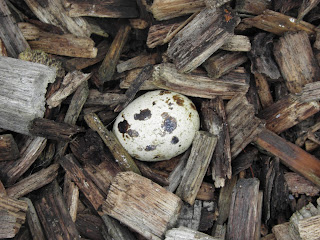 Being such a tiny bird, they do not need the largest of spaces, making them a great bird for people with limited room. They are however, perhaps rather unexpectedly, reasonable flyers so cannot be kept on a free range basis, but in an enclosure. We have set our new arrivals up here in the run of our display Long Legged Maggie's Dozen with a 9ft run, with their own smaller house underneath the larger, this gives them plenty of room to roam around all day. As quail are so small it is a good idea to put a timber skirting around the bottom of their enclosed area, or equally to make sure there are plenty of sheltered spots to keep them out of the wind and rain; a necessary for such a small bird with the climate our country has. You may find that if
Being such a tiny bird, they do not need the largest of spaces, making them a great bird for people with limited room. They are however, perhaps rather unexpectedly, reasonable flyers so cannot be kept on a free range basis, but in an enclosure. We have set our new arrivals up here in the run of our display Long Legged Maggie's Dozen with a 9ft run, with their own smaller house underneath the larger, this gives them plenty of room to roam around all day. As quail are so small it is a good idea to put a timber skirting around the bottom of their enclosed area, or equally to make sure there are plenty of sheltered spots to keep them out of the wind and rain; a necessary for such a small bird with the climate our country has. You may find that if you put your quail in a run or house with your hens, that they will be bullied by the much larger hens and beaten around, having their own space is always better. If you are thinking of getting some quail you will need to get some specialist quail feed. Higher in protein than normal poultry layers pellets, around 24%, this is the optimum feed for quail. They are prodigious egg producers as well, laying around 300 of their distinctive dabbled coloured eggs a year. So, once they are laying, some specialist quail egg boxes, designed for the much smaller eggs quail produce, are going to be in order. If you are interested in knowing more about quail, have a read of Katie Thear's book 'Keeping Quail', really the best book out there and filled with everything you could ever want to know about these unique little birds.
Now that they are firmly ensconced here as part of our FSF flock and ready to settle down into a life of luxury and leisure, they are truly happy. If you are calling in to our shop at any point, as you walk down from the car park to the barn, you will pass these little brown birds. However you might have to look hard for them, their mottled brown feathering on top of the woodchip make them almost invisible, as they zip back and forth around their run.
When we were first in conversation with Country Living Magazine and the Royal Horticultural Society about donating some of our beautiful hen houses to the RHS Hampton Court Palace Show and RHS Tatton Park Show; with the coops then going onto ebay to be sold to aid two worthy charities, the excitement was palpable.
Now with the closing of Tatton Park Show 2013 on the 28th July; after what seems the whole of the north (with not a flat cap in sight) flooded o'er hill and dale to visit the event, that excitement is subsiding. The displaying of the six hen houses decorated by celebrities such as Kate Humble and Deborah Meaden (as you are all now fully aware I am sure after my numerous blogs) received a paramount level of enthusiasm, admiration and interest. The amount raised by their auction on ebay, was merely the cherry on top of the cake, with a staggering £2046.55 going to two great charities; the RHS School Garden Scheme and Country Living's choice of the Addington Fund which supports British farmers, the whole enterprise has been brilliant and I wouldn't hesitate, in labeling the whole exploit a resounding success.
















